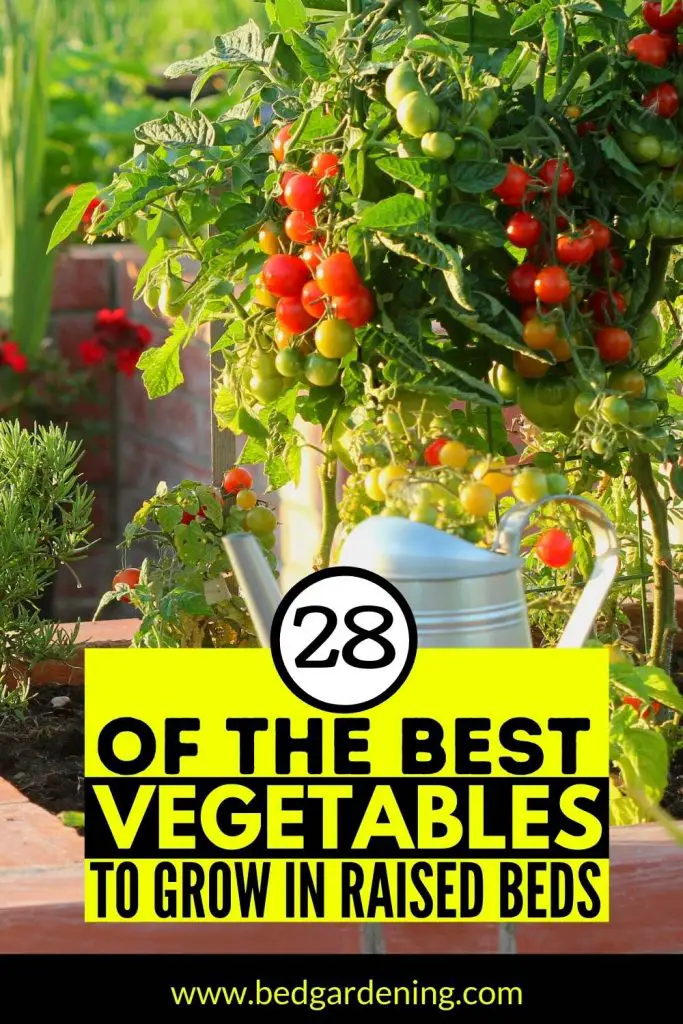Growing plants in raised beds is a great idea. There are different benefits of raised beds. After making the decision of growing plants in raised beds, the second question arises in your mind which type of vegetables you should grow in your garden.
A lot of options are available about vegetables but your decision should be according to your space, location, and different factors like sunlight, temperature, water, and climate.
For example, some plants like hot seasons and some like cold so you should grow those plants which have the ability to endure the weather of your area. In the same way, some plants need more water so if you are living in a dry area you should not grow them.
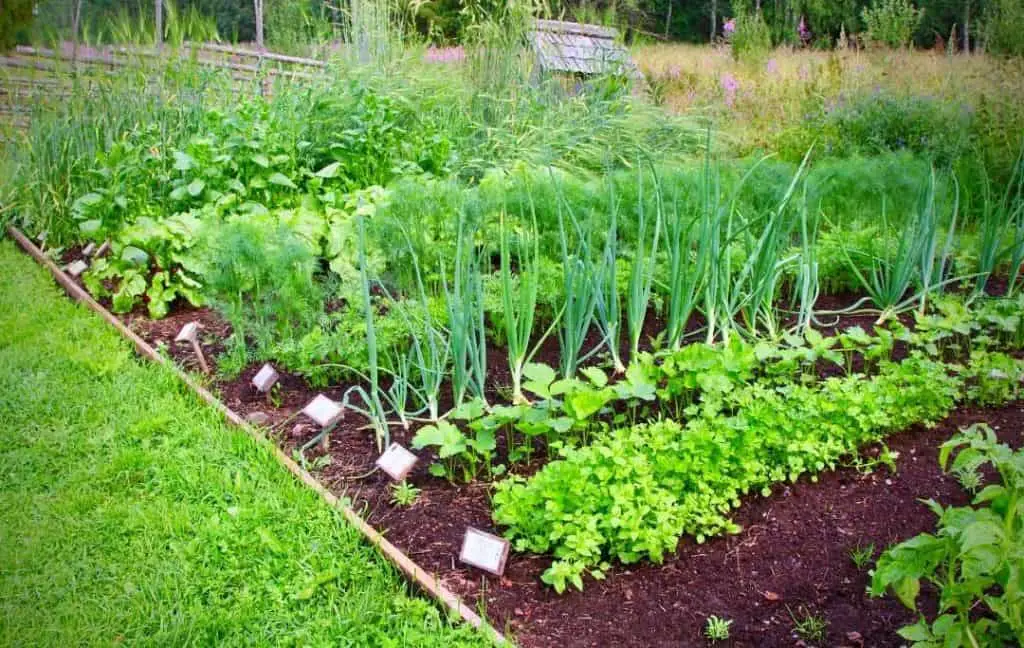
Here I will give you a brief description of about 30 best vegetables you can grow in raised beds. Hopefully, this article will help you in choosing the vegetable according to your area.
1- LETTUCE
In every salad or when we talk about garnishing especially burgers and sandwiches, it is impossible to deny the importance of lettuce. You should be careful about the fertility of the soil as it needs fertilizer for its growth. But don’t worry your hard work will not be lost.
You should not think too much about a suitable season for its growth as it can easily grow in fall as well as in spring. It needs partial sun, you can see your mature lattice within 2-3 months.
You should fertilize the soil every week. It is better if you add compost. The temperature of the soil must be cool and it needs regular water. Try to moisten them and cover your soil with mulch. It needs shade on hot days so select the location of your raised bed according to its requirement.
Read More: How to Grow Lettuce from Seed At Home
2- ONION
Onion is easy to grow vegetables but when you start planting it in a raised bed, it will become more simple. You can easily harvest onions within 100 days. They need rich and well-drained soil with full sunlight, little moisture is needed for its growth as the onion is a spring planter.
As it is mentioned above that onion is an easy to grow vegetable but it doesn’t mean you do not care for it. Nitrogen is an important factor for the better growth of plants so you should need to add nitrogen fertilizer continuously every 3-4 weeks.
Constant moisture is not a requirement of onion but if you provide constant water to your onion plants it will give you more flavor. Place the mulch layer and keep watering. From the top of the onion, you will come to know that the onion is ready for harvest. The yellow color of the top will tell this is the right to harvest.
Read More: How To Grow Onions From Onions?
3- CARROTS
Carrots are deep-rooted vegetables so you need to raise beds whose height is enough to give space to their roots. Mostly root veggies plant in the ground but if you are unable to control the conditions for their growth then it is better to grow them in raised beds. In a raised bed you can maintain the fertility of your soil.
Poorly draining soil will disfigure carrots but it is very good to add sand in soil because they love sandy soil. You should plant the carrots about 3-4 inches apart. In the first week, you should keep the soil moist for better yield. Carrots take 70 to 80 days to mature and you are able to eat them.
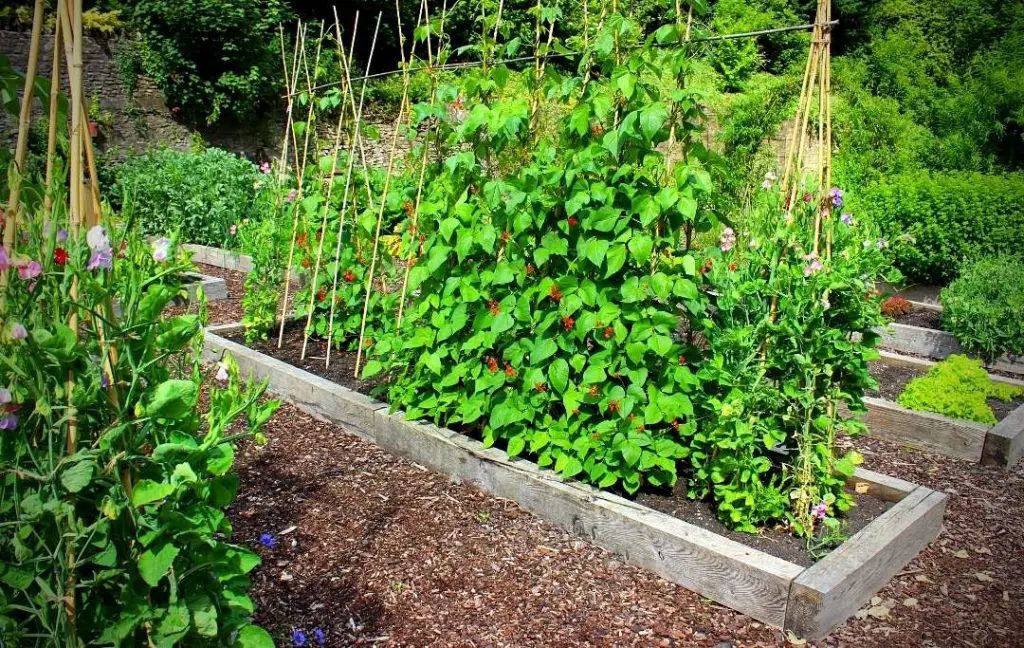
4- SUMMER SQUASH
Summer squash cant tolerates frost, important factors for its better growth are appropriate sunlight, good drainage, and moist, weed-free, and fertile soil. You should plant them before several weeks of last spring frost when the soil has warmed up.
It is easily planted by directly sowing seeds but you can also use seedlings for this purpose. Add mix compost into the soil before starting planting in raised beds. Fertilized the soil as necessary throughout the growing season. The maturity time of squashes is 2-3 months.
Read More: An Easy Way To Grow Pumpkins In A Raised Bed
5- POTATOES
Potatoes are everybody’s favorite vegetable, especially for children. By growing in your raised beds, you are able to get free potatoes for your kitchen. Providing full sun, rich and slightly acidic soil, and plenty of water, you will get your favorite vegetable for endless cooking possibilities.
For planting potatoes you should choose the right time. They cannot tolerate extreme cold so you should plant them before the last big frost of the season. Most varieties take a long time for maturity but generally, potatoes take two to three months for maturity.
6- MINT
You can’t face any difficulty growing mint in raised beds. It is very easy to grow and requires little maintenance. You can cut mint plants at any time as they have a tendency to spread. The unique thing about mints is that you can grow them from clippings, you can even grow these clippings in a glass of water.
There is no need to wait for harvesting but the best time for picking the leaves is when they are young enough. You can also pick them at any time. The fresh leaves of the mint will increase the taste of your favorite dishes as it is used in dressing and the main part of many sauces. There are many health benefits of mint hot mint tea is good for your stomach and anxiety relief.
7- CORN
The most amazing fast-growing vegetable is called you can grow it in large quantities. Some specific requirement is needed just like heavily fertilized soil, regular watering, and last you should plant it in spring. You can’t grow corn indoors; you should plant it outside.
It is possible To plant Kaun in a raised bed but it requires extra attention. You should leave appropriate space between the plants. Make it possible to give Water Your plants regularly this will maintain your soil moisture.
8- BEAN
Medium maintenance is required to get healthy beans, but one thing to keep in mind that if you are a beginner you can’t handle the pests of these plants. These plants require a vigilant gardener for maintenance. Try to provide the best soil composition with frequent watering, if your bean plants absorb all the nutrients from the soil then they will flourish in no time.
When you see the pods are firm and large you can harvest it. It is important if beans are large in size you should train them on a trellis, so they can easily climb on it. The small size beans do not need any support.
9- RADISH
It is a good option for a beginner because it can be harvested just within a month after planting with the help of consistent sun exposure and modest watering. You can maintain this easy to grow veggie in any type of soil.
As you know that radishes are deep-rooted plants, so keep a distance of 2 to 3 inches between them. You should choose a location for your raised bed where radish plants can get proper sunlight. The greens of the reddish are also edible. After harvesting, you should cut the green from the radish and save for cooking.
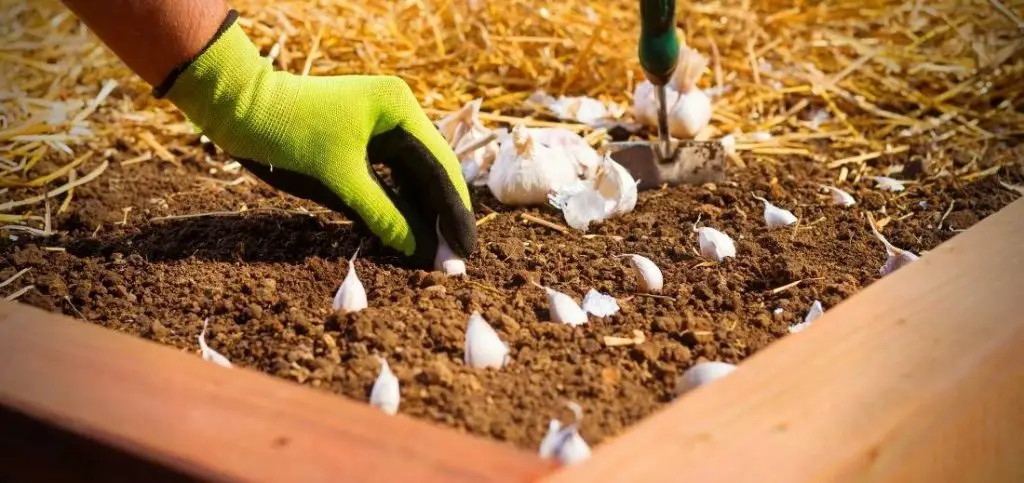
10- TOMATO
You can grow tomatoes in spring and summer. They love pots and raised beds. Extra support is needed because the heavyweight of the tomatoes need support when they start to grow. There are different varieties of tomatoes.
You should choose that variety which can easily and quickly produce yield. If you have a limited area or you are using a small size of raised beds for planting, cherry tomatoes are the best option as they produce delicious fruit in a single season.
Rich soil full of nutrients and mix with compost and fertilizers, 6 to 8 hours of full sun, and regular watering especially when baby tomatoes start to develop, are essential requirements for healthy tomatoes.
11- CUCUMBER
Hot weather lover, cucumber, like wet soil, and Plenty of nutrients. Choose your raised beds’ location where your plants get full sun. All nutrients which are required by cucumber can be easily available if you mix soil with compost and fertilizer.
This crop cannot bear frost so in the danger of frost avoid planting. Cucumber can be planted r with seeds or seedlings about one inch deep. Regular water is very essential for the sweet flavor of cucumbers if the soil is dry out which is not good for your cucumber plants.
12- PEPPER
You can easily grow pepper in raised beds. There are different varieties of peppers like traditional sweet bell peppers and hot peppers. When you are preparing your bed for planting make sure to mix your soil with high-quality natural fertilizer. Pepper is a sun-loving plant that needs frequent water but high quality and well-drained soil.
Pepper needs less water as it doesn’t mean that you avoid giving water on a daily basis. You should water them every day. You can also grow them indoors but you can not transplant them from indoors to outdoors. The plantation must be started before the last frost. You can harvest papers just using a sharp scissor when they reach your desired size.
13- PEAS
Peas are a fast-growing crop but when we talk about its growing season it is very short. Before planting the peas in raised beds you should use manure and fertilizers in the soil. They need 4 to 8 hours of sunlight and water regularly but don’t water them too much so that the rate of moisture increases in soil.
When you see the size of the pods is large enough according to your need then start picking the pea pods. The best time for harvesting is in the morning and you will get the best flavor when you pick them early.
Read More: How to Grow Peas in Raised Beds
14- BROCCOLI
Broccoli is easy to grow veggies that like cold weather. You should create a broccoli-friendly environment for the good production of this vegetable. Add compost and manure to increase the fertility of soil as broccoli likes a lot of nutrients.
The temperature of the soil must be 4.5°C (40°F). Its leaves show the deficiency of any nutrient like if there is a lack of nitrogen in the soil the leaves of broccoli turns into yellow, these symptoms help us a lot to find the main problem of the plant.
Be punctual in giving water to the plant. At the time of harvesting, you should be careful of the color of the head of broccoli if it is turning yellow or black it shows that they have passed their best time for harvest.
Read More: How to Grow Broccoli in Your Raised Beds?
15- SPINACH
SpinachIs a cold-loving plant, the planting time for spinach is spring or fall. You should not worry about its maintenance because it is a labor-light vegetable crop. But your soil must be well-drained without clay content.
If you are a beginner in the field of gardening then don’t worry it is a great crop for those who have zero gardening knowledge. Harvesting time is started when the leaves are big enough to eat, otherwise, their taste will be bitter. It is interesting to know that they are not limited to in-ground garden beds but you can try them in raised beds.
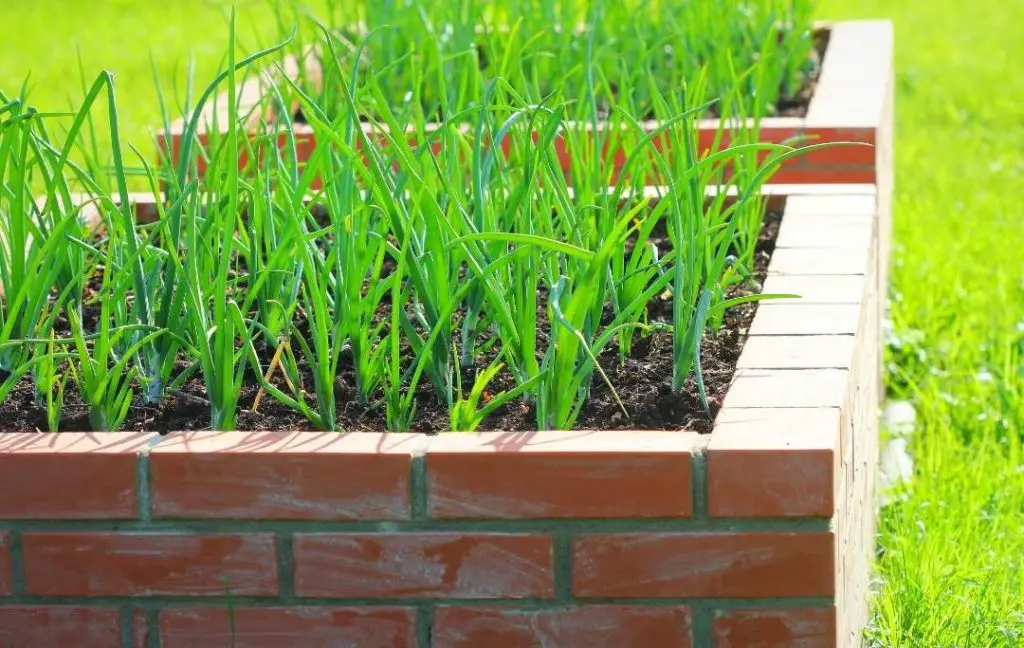
16- BEET
Beet has the ability to accept frost, that’s why you can plant them in early spring or fall. The high-quality soil is needed for their best growth. Plenty of nutrients, full of moisture and drainage are basic factors for the good production of beetroot.
If you are planting beetroot in raised beds then the depth of the bed should be large. You should maintain the moisture of the soil but don’t drown them. Try to spread a layer of mulch because it discourages weeds and helps to decrease the soil temperature.
It is important to know that when the roots are smaller in size they give sweet flavor and it is the best time to pick them. You can also use the greens of the beetroot because they are edible and it is an opportunity for you to pick them anytime as they are full of nutritious value.
17- KALE
Kale Is a cold-loving plant and likes well-drained and fertile soil. It is easy to grow a versatile plant. You can plant it in the spring or maybe in summer it is ready for harvest in the fall or early winter according to your plantation time.
All plants need full nutrient-rich soil, kale loves nitrogen and potassium so you should fertilize it throughout the growing season. when the height of the plant is about 6 to 7 inches or 15 to 18 cm you can harvest the leaves of Kale.
18- BASIL
Easy to grow plants which like hot weather. The basic requirement of the basil plant is moist soil and full sun. Choose the right spot where your basil plants get at least 6 hours of sunlight in the presence of moist and well-drained soil for basic nutrients.
Your frequent watering will give you the best yield. As it is a hot loving plant so you should water it daily especially if you are living in a hot environment.
19- CELERY
If you have patience you can grow celery in your raised bed as the maturity time of salary is about 160 days. You should soak the seeds in water in trays before planting, compost and fertilizer should be mixed to prepare the soil before planting. Celery needs a good amount of water to avoid hardness in stalks. Store it for two weeks to a month in your refrigerator.
20- LENTIL
The size of the lentils is very small so you can grow them in large quantities with the help of moist soil and full sun. Well-drained, nutrient-rich soil is needed along with 6 to 8 hours of sunlight.
You can easily grow lentils in raised beds if your soil is not ideal for growing but the height of the raised bed must be 8 to 10 inches. Regular watering keeps your plants healthy. The maturity time of lentils is about 100 days and you can easily store them as dry beans or grains. The storage time is about one year.
21- CABBAGE
Cabbages are heavy feeders so it is not an easy task to grow them in raised beds. If you have limited space you will be faced with great difficulty. A good amount of compost and manure should be added to the soil before planting so the requirement of the cabbage plant will be fulfilled.
The maintenance of the moisture and temperature of the soil is a great task. Pests love cabbages as much as people do but its nutrient-dense and flavourful leaves for you to grow them. To avoid diseases in cabbage plants is another task.
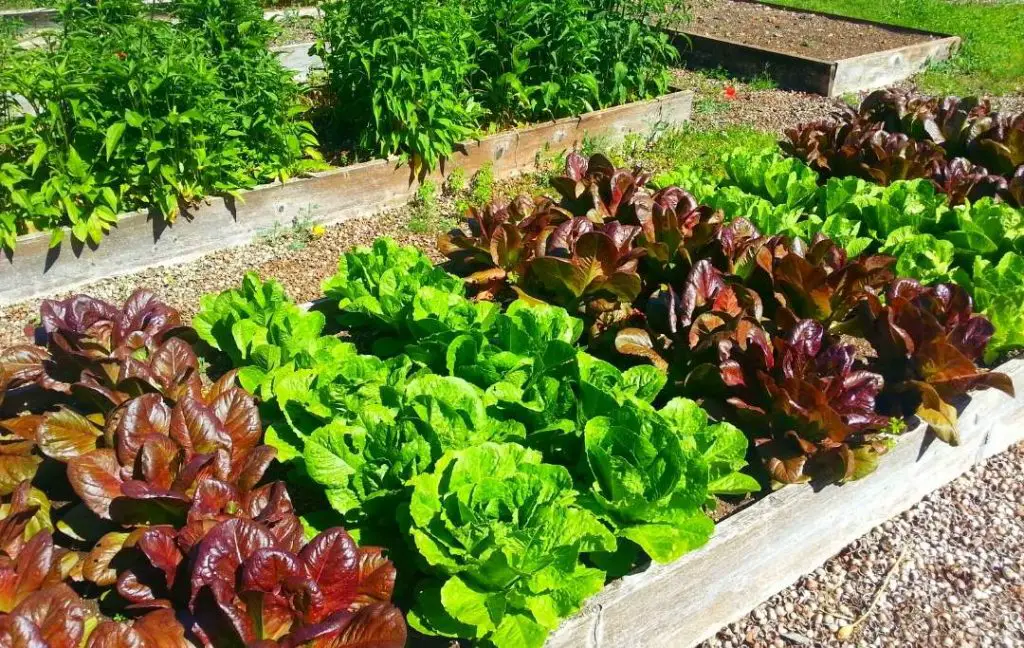
22- LEEK
You can buy leaks from any grocery store but if you grow them at home it will not cost you because they are easy to grow. Leeks do not need large space but full sun, rich soil and plenty of water are basic requirements for its better growth.
The size of the bulbs as compared to onion is small but the taste of the leeks is mild and sweet and you can also eat its leaves. Leeks are easily planted in the raised bed by adding high-quality soil with a layer of compost and little maintenance are basic requirements. You must keep your soil moist till harvest as they love moisture.
23- CAULIFLOWER
To grow cauliflower is not an easy task if you are an experienced and serious gardener. Your patience is required because it takes several months to mature. Consistent temperature is required so it is suggested that you should start it indoors preseason.
Prepare your perfect raised bed by adding a healthy amount of compost and manure and choose a location where your plants get at least 6 hours of sunlight. You should nitrogen supplement or a nitrogen-rich plant so your cauliflower will satisfy all its needs. Within 3 months this labor heavy brassica plant is ready for your kitchen.
24- ASPARAGUS
Trying to provide well-drained and rich soil for the great taste of asparagus plants. Select a fixed place for your raised bed and don’t rotate it because asparagus doesn’t like to be e disturbed. The best time for planting them in spring after the frost.
You will have to wait at least three seasons to harvest asparagus; it means patience is required. If you see dead or brown foliage then remove them from the plant every fall. For harvesting asparagus, you need a sharp knife.
25- ARTICHOKE
If you wait for the harvesting of artichoke then the return will be bigger for years to come. Full sun, loose soil with fertilizer are important factors for better yield. Weather is an important factor for the growth of any plant, especially, if you want to get multiple harvests. Frost is not good for your plants and it will kill them.
26- PURSLANE
The other name of purslane is pigweed. You can grow it anywhere in the summer months. The dry and well-drained soil is preferred for them. They don’t like cold weather and it needs full sun so you should be a little bit choosy about the location. The temperature would not get down below 10-degree centigrade. It is an easy crop so harvesting is as easy as growing.
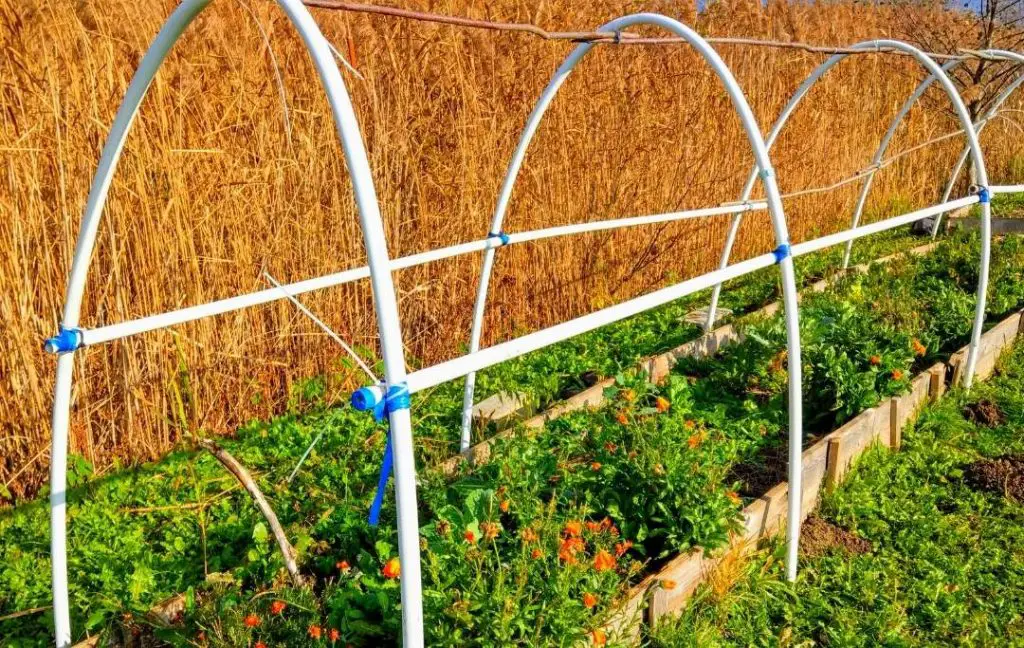
27- ENDIVE
Endives are Asian native leafy vegetables that require little maintenance and can be planted in the spring or fall. The temperature of the soil must be 16 degrees centigrade with full sun exposure; you can harvest it within 80 days.
You can plant it directly into the soil and water them regularly so the soil may not dry. You can easily grow these vegetables with periodic maintenance and try to keep the soil moist with regular fertilization after every 2 to 3 weeks.
28- CHARD
You can plant chard in spring and fall without any trouble. Chard is just like spinach which likes well-drained and nutrient-rich soil. It likes soil without clay, for best results make it possible that your chard plants can get at least 6 hours of sunlight.
Try to harvest your chard plants before they are overgrown. It is quick and easy to grow a plant that requires low maintenance. Due to its pretty look, people use it for decoration.

